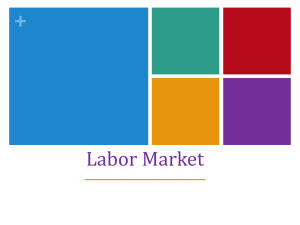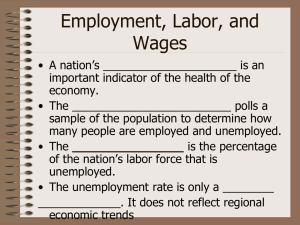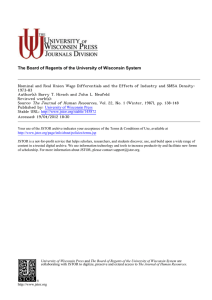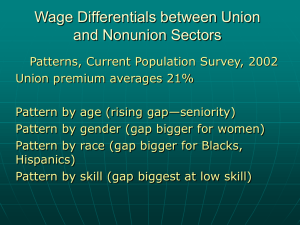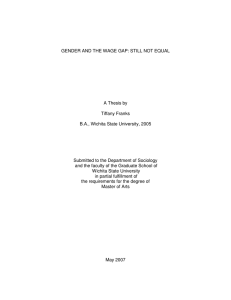File
advertisement
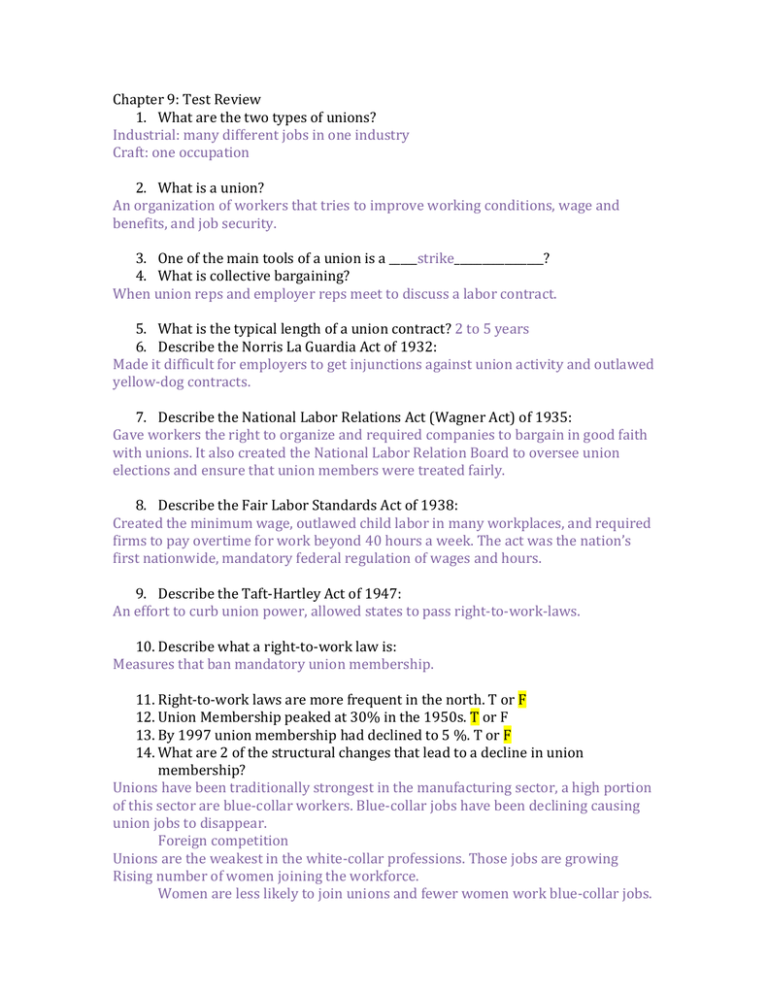
Chapter 9: Test Review 1. What are the two types of unions? Industrial: many different jobs in one industry Craft: one occupation 2. What is a union? An organization of workers that tries to improve working conditions, wage and benefits, and job security. 3. One of the main tools of a union is a _____strike________________? 4. What is collective bargaining? When union reps and employer reps meet to discuss a labor contract. 5. What is the typical length of a union contract? 2 to 5 years 6. Describe the Norris La Guardia Act of 1932: Made it difficult for employers to get injunctions against union activity and outlawed yellow-dog contracts. 7. Describe the National Labor Relations Act (Wagner Act) of 1935: Gave workers the right to organize and required companies to bargain in good faith with unions. It also created the National Labor Relation Board to oversee union elections and ensure that union members were treated fairly. 8. Describe the Fair Labor Standards Act of 1938: Created the minimum wage, outlawed child labor in many workplaces, and required firms to pay overtime for work beyond 40 hours a week. The act was the nation’s first nationwide, mandatory federal regulation of wages and hours. 9. Describe the Taft-Hartley Act of 1947: An effort to curb union power, allowed states to pass right-to-work-laws. 10. Describe what a right-to-work law is: Measures that ban mandatory union membership. 11. Right-to-work laws are more frequent in the north. T or F 12. Union Membership peaked at 30% in the 1950s. T or F 13. By 1997 union membership had declined to 5 %. T or F 14. What are 2 of the structural changes that lead to a decline in union membership? Unions have been traditionally strongest in the manufacturing sector, a high portion of this sector are blue-collar workers. Blue-collar jobs have been declining causing union jobs to disappear. Foreign competition Unions are the weakest in the white-collar professions. Those jobs are growing Rising number of women joining the workforce. Women are less likely to join unions and fewer women work blue-collar jobs. 15. Match the definition to the correct term: Closed Shop: B Union Shop: A Agency Shop: C a. This type of workplace will hire nonunion members but requires them to join the union within a certain period of time. b. This type of workplace hires only union members and is now illegal. c. This type of workplace will hire nonunion members and does not require them to join the union in order to keep their jobs. However, nonunion workers must pay union dues or similar fees, and they are covered by the union contract. 16. All nonmilitary people who are employed or unemployed is the general definition of? a. Workers b. Labor Force c. Students d. Civilians 17. What is the economic definition of employment? People are considered employed if they are 16 years or older and meet at least one of the following requirements: They worked at least one hour for pay within the past week They worked 15 or more hours without pay for a family business They held jobs but did not work due to illness, vacation, labor disputes, or bad weather. 18. What is the economic definition of unemployment? People are considered unemployed if they are 16 years or older, are not institutionalized and meet one of the following criteria: They are temporarily laid off from their job They will be reporting to a new job within 30 days They are not working but have actively looked for jobs within the last 4 weeks. 19. What does BLS stand for? Bureau of Labor Statistics 20. Which of the following is NOT one of the questions that the BLS tries to answer? a. How many people are in the labor force? b. How many people are not in the labor force? c. How many people are employed or unemployed at any given time? 21. How often is the unemployed rate reported? Monthly 22. Employment and unemployment in a labor market depends on how closely the ___demand____________ for workers meets the ____supply_____________ of workers ____seeking jobs___________________. 23. What does productivity mean? Value of output 24. Where does the demand for labor come from? Firms and government agencies. 25. Where does the supply of labor come from? Households 26. The wage rate that produces neither an excess of supply or workers nor an excess of demand of workers in the labor market is the __equilibrium__ wage. 27. List, describe, and give one example of the four skill levels: a. Unskilled labor: no specialized skills, education, or training. Hourly wage. Examples: janitors, farm workers. b. Semi-Skilled labor: minimal specialized skills and education, such as the operation of certain types of equipment. Hourly wage, example: lifeguards, some construction workers, short-order cooks. c. Skilled labor: Requires specialized skills and training to do tasks such as operating complicated equipment. Need little supervision and usually earn an hourly wage. Examples: auto mechanics, firefighters, chefs, carpenters, and bank tellers. d. Professional labor: demands advanced skills and education. Usually whitecollar workers who earn and salary, examples: teachers, bankers, doctors, lawyers, and professional athletes. 28. The Equal Pay Act of 1963 declared what? That men and women employees in the same workplace performing the same job had to receive the same pay. 29. Title VII of the Civil Rights Act did of all of the following but what? a. Forbid job discrimination on the basis of race, gender, color, religion, or nationality. b. Start enacting affirmative action. c. Created the Equal Employment Opportunity Commission (EEOC) d. Created a national job search organization. 30. Women today earn only about ___75%_______ of what men earn. 31. Define Glass Ceiling. The invisible barrier that prevents some women and minorities from advancing to the top ranks of business. 32. Describe the relationship that can exist when it comes to minorities and wage. Tend to earn lower wages than whites, on average whites have more access to education and work experience. Minorities can, due to discrimination, receive less pay than their counterparts for doing the same job. 33. Union members tend to earn lower wages than nonunion workers for similar jobs. T or F. 34. Union members are far less likely to enjoy benefits such as pensions and medical insurance. T or F. 35. Unions lower the wages of nonunion workers. T or F. 36. Describe the term featherbedding and give an example. Negotiating labor contracts that keep unnecessary workers on the company payroll. Railroads. 37. Describe the learning effect. The theory that education increases productivity and results in higher wages. 38. Describe the screening effect. The theory about the relationship of education to wages. This theory suggests that the completion of college indicates to employers that a job applicant is intelligent and hard-working. 39. Describe contingent employment. Temporary/part-time jobs. People hired for a specified time period or to complete a certain task.
